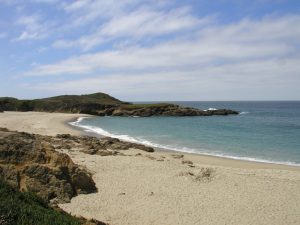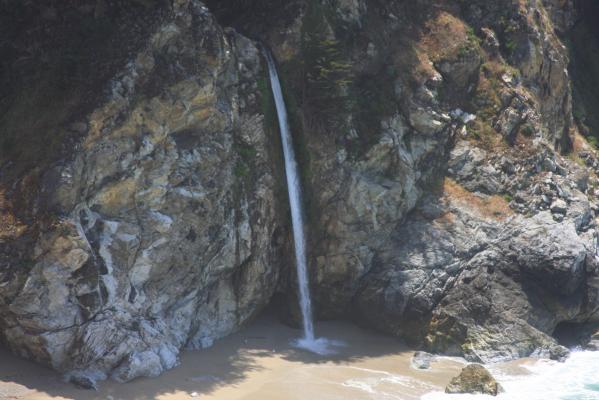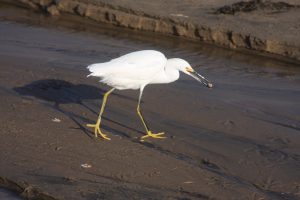Beaches are one of the most visible and popular habitats in the west coast sanctuaries. Cordell Bank National Marine Sanctuary has no beaches; it is completely offshore.

Sand beaches can be common: for example, they represent about half the intertidal habitat in MBNMS. To the north, this habitat is an important part of the Greater Farallones sanctuary coastline, particularly along the Sonoma and Mendocino county coastlines. Beaches along the shores of Olympic Coast NMS are scenic and popular among photographers, with nearshore sea stacks jutting into the sky.
Inhabitants
Although it may not be obvious at first glance, a beach’s constantly moving sand forms a very rich and productive intertidal habitat, particularly in California. In fact, thousands of mobile animals live along every foot of the shoreline.
In the northern California region, there are two main sources of organic material for beach food webs: microscopic phytoplankton (which nourish filter feeders) and drift seaweeds.
Filter Feeders
Animals such as sand crabs and clams eat the phytoplankton delivered by waves and tides.
Sand crabs are often the most abundant invertebrate animal on the beach. Aggregations can be detected in the swash zone (where the waves wash in and out) by the telltale rough texture caused by their extended antennae as they filter the backwash of outgoing waves for food.

Clams are another important filter feeder on the beach. They use muscular siphons to reach the wave water and feed while their shells stay buried safely in the sand. Pismo clams, for example, are often found on wide, flat beaches with fine sand. They can live in and outside the surf zone in sandy areas, as can sand dollars.
Kelp and Seaweed
Drift kelp and other seaweeds can wash up on the beach in large amounts, especially when strong waves or storms break them off rocky reefs. Beach animals that eat drift kelp and other algae are often small crustaceans and specialized intertidal insects.
Beachhoppers, or sand fleas , prefer to eat brown macroalgae or kelps, particularly the blades of giant kelp and feather boa kelp. It has been estimated that this community of animals is capable of consuming more than 70 percent of the annual input of macroalgal wrack to a beach. Many beetle species can be found on beaches; some are herbivores, feeding on wrack and other drift material, but many of them are predatory. Several of the important predatory beetles are flightless, such as the rove beetle, which preys on beachhoppers.

The presence of these specialized invertebrate predators, which also include spiders and centipedes, on a beach can indicate a reliable sand and wrack supply and a relatively low level of human impacts.
Conservation and Management Issues
Beaches suffer from a number of challenges. These include water quality, coastal armoring and marine debris.
- Water quality: Various agencies and citizen groups test for levels of coliform bacteria, which are indicators of contaminants that may cause sickness in humans. Oil pollution, another important water quality issue, can come from many sources, including land runoff, poor vessel maintenance and vessel spills.
- Coastal armoring: Structures that have been installed to prevent the natural erosion of the coastline can potentially damage or alter local coastal habitats and deprive beaches of sand.
- Marine debris: trash is dumped overboard by ships at sea, carried by rivers and storm drains from inland areas, and deposited directly on beach areas by visitors. Regardless of its origin, much of this refuse ends up on beaches and can pose a threat to seabirds, marine mammals and turtles.
Monitoring
The sanctuaries and their partners conduct a variety of research initiatives to monitor northern California beaches.
Long-Term Monitoring Program & Experiential Training for Students (LiMPETS) , a program for middle schools, high schools and other volunteer groups, was developed to monitor rocky intertidal, sandy beach and offshore areas of the five West Coast national marine sanctuaries. Participants monitor the abundance and distribution of major intertidal biota, sand crabs and selected offshore species to increase awareness and stewardship of these ecosystems.
Beach Watch is a long-term beach monitoring program (active since 1993) for the Greater Farallones sanctuary. Trained volunteers conduct surveys every two to four weeks, with the goal of developing status and trend information on the sanctuary’s biological resources and human uses.
A similar program for the Monterey Bay region is called Coastal Ocean Marine Mammal & Bird Education and Research Surveys (Beach COMBERS). In this collaborative effort, trained volunteers have surveyed beached marine birds and mammals monthly at selected beach sections throughout the area since 1997.
Examples of related monitoring projects: